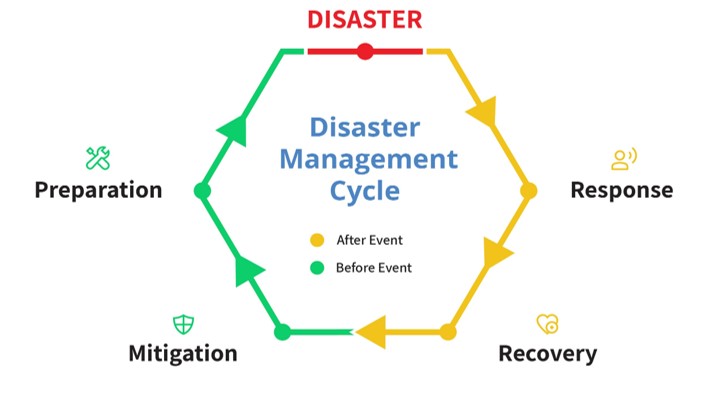


When we think about disasters, we often picture homes destroyed, families displaced, and communities struggling to rebuild. What we rarely consider is the unique impact these catastrophes have on people with disabilities. It's a stark reality that individuals with disabilities face heightened risks and challenges during disasters, yet their needs are often overlooked in disaster preparedness and response efforts.
Disasters do not discriminate, but disaster response often does. Persons with disabilities (PwDs) face a double burden during such crises. Physical barriers, lack of accessible information, and inadequate preparedness measures exacerbate their vulnerability. Imagine being unable to hear evacuation warnings during a flood or navigating inaccessible shelters in the aftermath of an earthquake or the plight of a woman with profound disability undergoing her monthly menstruation in a makeshift relief camp with inadequate and inaccessible sanitary facilities. For many people with disabilities, these are not hypothetical scenarios but harsh realities. Addressing these needs is crucial to ensure that emergency plans include accessible transportation, medical support, and adequate sanitary provisions, making evacuation and sheltering safer and more manageable for all women.
Further, as the planet warms, we are witnessing a surge of unprecedented disasters - scorching heat waves, sudden flooding in areas that were once unaffected, and other climate-induced calamities that challenge our understanding of natural patterns. These new realities underscore the urgent need for updated preparedness plans, yet many remain ill-equipped, particularly in the realm of inclusive Disaster Risk Reduction and Resilience (DIDRR). Without incorporating diverse needs, especially those of the most vulnerable, our responses to such crises will remain inadequate, putting numerous lives in greater danger as the climate changes.
Statistics Paint a Grim Picture
Globally, approximately 16% of the population lives with disabilities (states WHO ‘Disability and Health’), and these individuals are two to four times more likely to die or get injured during a disaster compared to those without disabilities. In India, around 4.5% of the population has disabilities (National Family Health Survey-5, 2019-21), with Assam alone accounting for 1.54% of Assam Census 2011 Data.
While Assam holds the 15th position in terms of population in the country, it ranks 8th in the composite disaster risk index across states and union territories. According to a recent study by the Ministry of Home Affairs, Government of India, and United Nations Development Programme (UNDP), Assam ranks highest in earthquake risk and second highest in flood risk. Each year, it faces diverse losses and impacts due to its susceptibility to multiple hazards and contributing factors.
Personal Stories of Resilience and Neglect / The Invisible Struggle
During a flood rescue operation in one of the districts of Assam, rescue workers came across a mother who, despite the escalating floodwaters, was determined to stay with her disabled son and would not abandon their home. This poignant incident underscores the critical need for improved support systems for people with disabilities during crisis situations. Since her son was unable to move on his own, the mother chose not to evacuate, and tragically, a few days later, it was reported that both she and her child had been swept away by the floodwaters.
This case was shared at a recent state-level consultation on pre-monsoon preparation and disability-inclusive disaster risk reduction, organized by Shishu Sarothi and the Rural Volunteers Centre (RVC) in collaboration with the Inter-Agency Group (IAG) Assam.
Such stories are far too common, highlighting the critical gaps in our disaster response systems. During the Uttarakhand floods in 2013, many PWDs were left stranded. Evacuation plans did not account for their mobility needs, and shelters lacked basic accessibility features. Similarly, the Chennai floods of 2015 saw PWDs trapped in their homes, with rescue efforts failing to provide necessary accommodations on a timely basis. During the 2004 tsunami, 700 individuals with post-polio paralysis on an island in the Andaman archipelago in the Bay of Bengal perished because they were unable to reach the higher ground of the surrounding hills.
The above scenarios starkly illustrate the pressing need for disaster response strategies that are inclusive and sensitive to the unique needs of PwDs. It highlights the importance of prioritizing the safety and accommodation of PwDs within emergency shelters and relief efforts. Besides providing ramps and tactile paths for locomotor access, visual alarms, captions, audio descriptions, and braille materials for information accessibility, there are other measures that have to be taken for people with other disabilities. For instance, people with autism and intellectual disabilities face unique challenges during disasters. Sudden changes and chaotic environments can be particularly distressing for them, as they often rely on consistent routines and familiar surroundings. During evacuations and in shelters, their specific needs for structured environments and clear, calm communication must be met to avoid heightened anxiety and confusion. Ensuring that shelters provide a stable and supportive environment can help them better cope with the stress of a disaster and improve their overall safety and well-being.
Planning for DIDRR:
Disaster management often emphasizes post-disaster relief - providing food, shelter, and medical aid. While these efforts are crucial, they are reactive. Proactive measures are equally important, and it is crucial that each step of the disaster management cycle - preparation, response, mitigation, and recovery – be inclusive, especially of vulnerable populations, including children, women, people with disabilities, elderly population, and low-income groups.
Some key steps for effective DIDRR, vis-à-vis persons with disabilities include:
1. Preparedness plans that account for the specific needs of persons with disabilities like ensuring accessible evacuation routes and having support systems in place are crucial because it significantly reduces the risks and impacts of disasters for them. Effective preparedness can mean the difference between life and death, ensuring that everyone, regardless of their abilities, has the best chance to survive and recover.
2. Community-Level Data Collection: Understanding the number of persons with disabilities in a community and their specific needs is the first step. This data should be incorporated into risk assessments and preparedness plans well before disaster strikes.
3. Accessible Infrastructure: Ensuring that evacuation routes, shelters, and communication systems are accessible to everyone, including those with mobility, hearing, or vision impairments.
4. Training and Sensitization: First responders and community volunteers should be trained to understand and address the unique needs of people with disabilities. This includes not just physical assistance but also empathetic communication and support. Additionally, individuals with disabilities should be educated on emergency protocols, and they should be actively involved in regular practice drills, including evacuation exercises.
5. Inclusive Communication: Information about impending disasters and evacuation plans must be disseminated in accessible formats like sign language, Braille, and simple, clear language for those with cognitive disabilities.
Legal Mandate:
Various global and national treaties and mandates advocate for the inclusion of people with disabilities in disaster risk reduction efforts. Significant agreements, including the UN Convention on the Rights of Persons with Disabilities (CRPD), emphasize accessibility and inclusivity in disaster planning (Article 11). With core principles that uphold individual dignity, autonomy, equality, accessibility, and participation, these frameworks highlight the necessity of incorporating individuals with disabilities into all aspects of disaster and emergency preparedness.
Section 8 of the Rights of Persons with Disabilities Act, 2016 emphasizes the protection of disabled individuals during disasters and assigns the responsibility of their inclusion in disaster management to the National and State Disaster Management Authorities. It mandates the District Disaster Management Authority to keep records of disabled individuals and ensure they are informed about risks to improve disaster preparedness. Additionally, the Act requires that reconstruction efforts following disasters be conducted in accordance with accessibility standards for persons with disabilities.
Going Forward
Summing up, here is an overview of some measures that have to be considered to ensure effective and inclusive disaster risk reduction provisions:
1. Study and Research: Acquiring in-depth knowledge from research about vulnerable populations, disaster impacts, and the specific needs of people with disabilities enables the creation of comprehensive DIDRR strategies. This understanding also highlights the necessity for realistic budget allocations to effectively implement these plans in practice.
2. Preparedness Planning: Comprehensive preparedness planning must prioritize people with disabilities by including accessible early warning systems, evacuation routes, and shelters with proper facilities. The recent floods in Assam highlight the urgent need for such measures to mitigate losses. By addressing these specific needs, the impact of disasters can be reduced, potentially saving lives and minimizing injuries.
3. Voices of PwDs: Including the voices of people with disabilities (PWDs) in disaster risk reduction planning and implementation is vital. Their insights enhance the effectiveness of strategies. Practical involvement, such as participating in mock drills, ensures PWDs are prepared to protect themselves during disasters. This engagement helps identify barriers and improves disaster response strategies, making them more effective and inclusive for everyone.
4. Collaboration and Partnerships: Building strong partnerships between government agencies, non-governmental organizations (NGOs), and disability advocacy groups can enhance disaster preparedness and response efforts. Collaborative approaches ensure that diverse needs are addressed and that resources are allocated efficiently.
5. Monitoring and Evaluation: Implementing monitoring and evaluation mechanisms to assess the effectiveness of DIDRR measures and identify areas for improvement is crucial. Regular assessments help refine strategies and ensure that they are meeting the needs of all community members, including those with disabilities.
In conclusion, addressing the unique needs of people with disabilities in disaster risk reduction requires a multifaceted approach that includes proactive planning, inclusive practices, and ongoing engagement with affected communities. By prioritizing accessibility and inclusivity in disaster preparedness and response, we can create safer and more resilient communities for everyone.